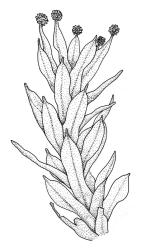Elements in the following description are taken from Crum & Anderson (1981), Eddy (1990) and Reese & Stone (1995).
Plants small to robust, extremely variable in habit, mostly forming tufts or sometimes dense cushions, usually on tree trunks or rocks. Stems erect or sometimes creeping (in Mitthyridium), often forked. Leaves mostly ligulate or lingulate from an erect and pale base, often distinctly shouldered and sometimes dimorphic (with gemmiferous leaves differing in shape from non-gemmiferous leaves), with conspicuous areas of enlarged, thin-walled and pale cells (cancellinae) in the base, usually bordered by either thickened concolourous cells or linear and pellucid cells, and these often intramarginal (teniolae, as in Calymperes), usually bearing septate and fusiform or cylindric gemmae on the lamina or near the tip of the costa; upper laminal cells small, firm-walled, mostly round or round-quadrate, often mammillose or papillose on one or both sides; interior basal cells sharply differentiated in conspicuous groups (cancellinae) of inflated, empty, hyaline, and often porose cells; alar cells not differentiated. Costa strong, subpercurrent to excurrent, in cross-section with two stereid bands, often with a generative area at the apex bearing conspicuous clusters of multicellular gemmae. Gemmae fusiform or linear, transversely septate.
Dioicous (rarely monoicous). Setae smooth, mostly elongate; capsules erect and cylindric; annulus lacking; operculum rostrate. Peristome single, of 16 narrow, ± papillose teeth, or absent (in all Calymperes and some Syrrhopodon). Calyptra either cucullate or mitrate and clasping at base, sometimes rough near apex.
The Calymperaceae are a pantropical family occurring predominantly on tree trunks or rock, and only rarely on soil. Goffinet et al. (2009) included eight genera in the family, including several "leucobryoid" genera (such as Octoblepharum) in which costa and leaf lamina are composed primarily of dead leucocysts. The relationships to the Leucobryaceae (sensu Brotherus 1924) have never been satisfactorily resolved. Reese & Stone (1995) argued for a more restricted concept of the family, including only three genera: Syrrhopodon, Calymperes, and Mitthyridium. The family description above applies to the family in this restricted and traditional sense. The controversy concerning the limits of the family is of little consequence in a N.Z. context, since only two species occur on the main islands and one additional species occurs on the Kermadec Is. Reese et al. (1986) provided a summary of the controversy surrounding family delimitation. Both Calymperes and Syrrhopodon are large, pantropical genera.
The family and its component genera are taxonomically difficult in all parts of its tropical range. All members of the family have two large and conspicuous areas of thin-walled, enlarged and often porose cells ("cancellinae") in the leaf base. The cells of the cancellinae contrast sharply in size to the smaller, chlorophyllose cells of the upper lamina. Species very often bear clusters of multi-cellular gemmae near the costal apex, often on its adaxial surface.
No attempt is made either to present here a key that will separate non-N.Z. Calymperes from Syrrhopodon or to present descriptions of these highly diverse genera. Interested students might wish to consult keys for other regions where the family is more diverse, such as those for Australia (Reese & Stone 1987, 1995), Malesia (Eddy 1990), or the Huon Peninsula, P.N.G. (Reese et al. 1986).
The genus Mitthyridium is not documented from N.Z.; it can usually be recognised by conspicuous cancellinae, broad borders of elongate cells that extend far up the leaf margins, a creeping habit, and cucullate, deciduous calyptrae. It is a genus of c. 15–20 species predominantly distributed in palaeotropical regions, including the Pacific islands (Reese & Stone 1995).
| 1 | Leaf margin bearing long, unicellular and patent or retorse spines near base; costa c. 60 µm wide near top of the cancellinae, armed with single-celled spines abaxially, subpercurrent; stems beset below with brick-red rhizoids | Syrrhopodon |
| 1' | Leaf margin lacking spines; costa stouter, c. 100–120 µm wide near top of the cancellinae, lacking abaxial spines, excurrent; stems without conspicuous red rhizoids | Calymperes |
| Category | Number |
|---|---|
| Indigenous (Non-endemic) | 3 |
| Total | 3 |




